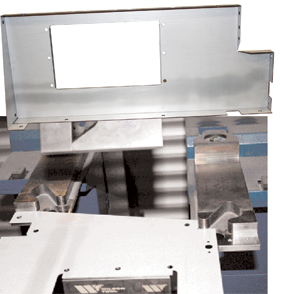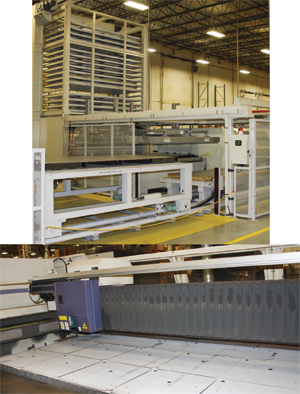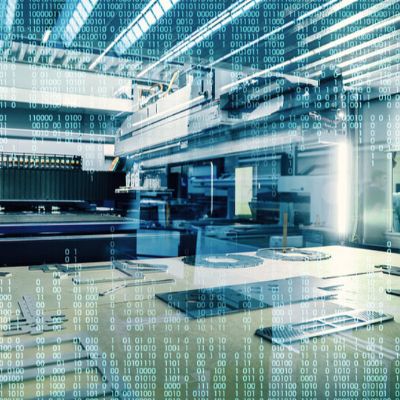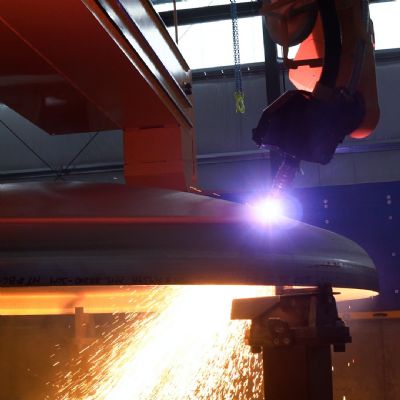“We had been running two shifts in the fabrication department just to keep pace with assembly,” Busby notes, reflecting on the excessive amount of hours needed to nibble part contours on its pair of aging turret presses. “We noted efficiency problems on the second shift in particular, and went looking for a better solution, and after 18 months of searching settled on a 4-kW Mitsubishi machine (Model 3015 LVP) with a 20-shelf material-storage tower.” Along with the laser came automated nesting software to optimize sheet utilization and minimize scrap.
 |
| When engineers approached the Helmer fabrication shop with this complex design for odd-shaped legs for a new under-the-counter line of refrigerators, six-axis backgauging on its new CNC press brake came to the rescue. Forming the legs on a two-axis brake would have required operators to hang the part—10 by 24 in.—off of the edge of the tooling, creating a very difficult-to-control process. Fabricating the legs on the new brake with the independent backgauges (below) allows the operator to locate the part in two places and ensure precise alignment and accuracy. |
Helmer employs a kanban production system, anticipating production requirements in order to keep the material-storage tower loaded with the material needed. It rarely loads the laser-cutting table manually, says Busby. Most often, the machine processes 5- by 10-ft. sheets, the majority of which are cold rolled and galvanized steels. It processed 680 tons of steel in 2009, including 154 tons of stainless. Thickness ranges from 10 to 20 gauge, with a bit of thicker aluminum—1⁄16 to 3⁄16 in.—thrown into the mix.
"The laser has replaced a lot of nibbling that we used to perform on the turret presses,” says Busby. “Now only five to 10 percent of our parts require any turret punching at all. Laser cutting our parts eliminated nearly all post-op deburring. Edge quality is superb, and we can run the laser unmanned.”
The machine runs 18 hr./day, 10 of which are lights-out. And it went from running two turret presses two shifts each, both tended by operators, to running one turret press 6 hr./day.
Cutting with Shop Air
At install, laser cutting occurred with nitrogen assist—in fact, the firm installed a bulk- nitrogen tank outside its facility to feed the laser. But now the firm cuts mostly with shop air, with great results to show for the economical switch.
“Shop air through a 2-mm nozzle provides excellent edge quality on all of our galvannealed and galvanized stock,” Busby says. “We only run nitrogen to cut stainless steel and aluminum. All we had to do was add a second dryer on the shop-air line to ensure the delivery of clean, dry air to the machine.”
Six-Axis Press Brake
More Flexible, More Capable
“Recently, we’ve been performing a lot of hemming operations on our sheetmetal enclosures to eliminate riveting in assembly,” Busby continues. “We took on this additional task after investing in a new press brake (a Trumpf TruBend 5085, rated to 94 U.S. tons of bend force) outfitted with six-axis backgauging, as well as new hemming tooling (from Wilson Tool, White Bear Lake, MN). Along with the new hemming tooling came a new Wilson parting tool for Helmer’s turret press that, compared to the ¼-by-3-in. rectangular punch it had been using for parting, “holds the punch much more firmly,” says Busby. “We can run that tool 30 hr. or more between sharpenings, compared to only 10 to 12 hr., or barely one shift, before.”
“Our older brakes have two-axis back-gauges—six axes give us added flexibility,” Busby continues. “The two halves of the backgauge can move independently.”
Asked to elaborate on how added backgauge flexibility pays off, Busby describes a recent design innovation handed off to his group for a new under-the-counter line of refrigerators.
“The design included very odd-shaped legs,” he says, “and forming the legs on our older brakes would have been very challenging. Our operators would have had to hang the part off of the edge of the tooling to put some of the bends in, resulting in a very difficult-to-control process. Fabricating the legs on the new brake with the independent backgauges allows the operator to locate the part in two places and ensure precise alignment and accuracy.” MF
Industry-Related Terms: Scrap,
Stainless Steel,
Thickness,
Turret Press,
Turret,
Blank,
CNC,
Edge,
Forming,
Gauge,
LASER,
Nesting,
RunView Glossary of Metalforming Terms
See also: TRUMPF Inc., MC Machinery Systems
Technologies: Cutting
 Brad Kuvin
Brad Kuvin









